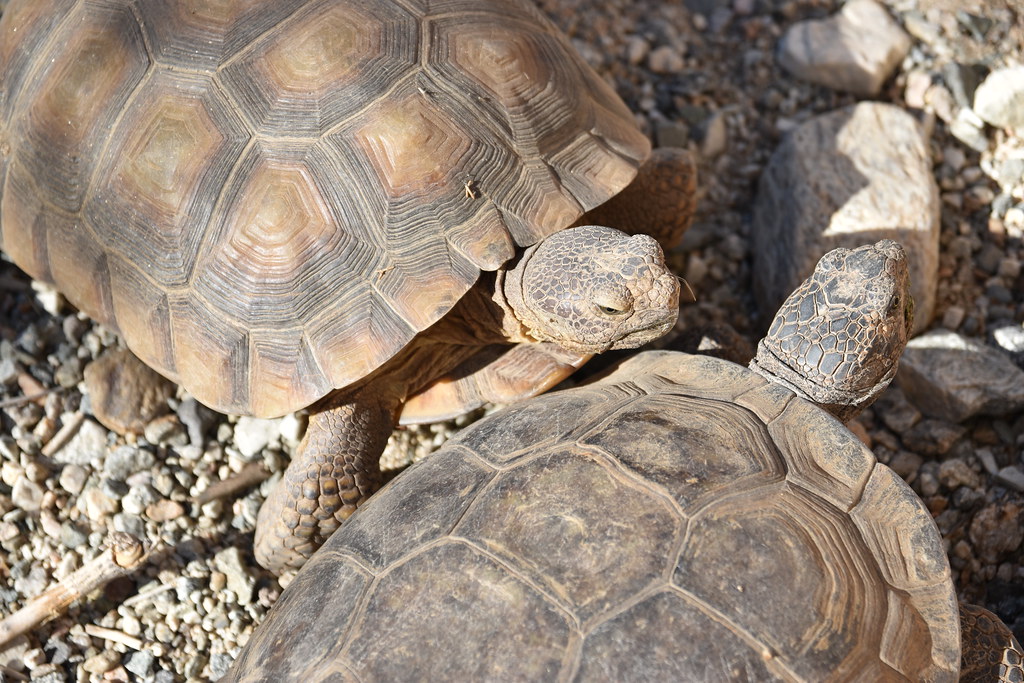
Image Source: Flickr
Want to create a home for your desert tortoise? Look no further! This article has all you need to know. Whether experienced or a beginner, we’ve got you covered.
Creating the perfect habitat requires careful consideration. From selecting the right enclosure to providing shelter and vegetation – each element is important for your tortoise’s well-being. Follow our advice and you’ll be able to design a habitat that mimics their natural environment.
Temperature gradient within the habitat is a key detail that often gets overlooked. Desert tortoises are ectothermic creatures, meaning they rely on external heat sources to regulate their body temperature. Provide both warm basking areas and cooler shade spots for your tortoise to move freely and adjust their body temperature as needed.
Don’t forget about enrichment activities! Hiding spots, climbing structures and shallow water features will improve their quality of life. Stimulate their natural instincts and you’ll have a complete desert tortoise habitat.
Don’t miss out on the opportunity to create a safe and comfortable home for them! Start building your own paradise today!
Key Takeaways
- Research and understand the needs of desert tortoises: Before building a habitat for desert tortoises, it is crucial to gather information about their natural habitat, diet, and behavior. This will help ensure that the habitat you create meets their specific needs.
- Provide a suitable enclosure: Desert tortoises require a spacious and secure enclosure to thrive. The habitat should have a solid perimeter fence to prevent escape and protect them from predators. It should also include both sunny and shaded areas to allow the tortoises to regulate their body temperature.
- Create a burrow: Desert tortoises are known for their burrowing behavior, so it is important to provide them with a suitable burrow within their habitat. This can be achieved by digging a hole and lining it with rocks or logs to create a safe and comfortable space for the tortoises to rest and hibernate.
- Offer a varied diet: Desert tortoises have specific dietary requirements, including a mix of grasses, weeds, and leafy greens. It is essential to provide a diverse range of vegetation within their habitat to ensure they receive the necessary nutrients.
- Provide fresh water: While desert tortoises obtain most of their water from the plants they eat, it is still important to provide a shallow water dish within their habitat. This will allow them to drink and soak if needed, especially during hot and dry periods.
- Maintain a clean and safe environment: Regularly clean the habitat to remove any waste or debris that may accumulate. Additionally, ensure that there are no toxic plants or materials within the enclosure that could harm the tortoises.
- Seek professional advice if needed: If you are unsure about any aspect of building a desert tortoise habitat, it is always best to consult with a professional or seek guidance from a local reptile or wildlife organization. They can provide expert advice and ensure that your habitat meets all necessary requirements for the well-being of the tortoises.
Understanding the Needs of a Desert Tortoise
Secure the well-being of desert tortoises with the right habitat. Must be warm and dry, with both sun and shade. Include a burrow, sandy soil for digging, and vegetation for food. Also, regulate temperatures and humidity.
To replicate their natural environment:
- Pick a sunny spot. This helps them to regulate their temperature.
- Set up shade with rocks or artificial structures.
Burrows need to be large enough for tortoises. Either dig under rocks or use non-toxic materials such as PVC pipes or wooden boxes. Ensure soil’s not prone to flooding.
Feed tortoises grasses, greens, and native desert plants. Avoid high-protein foods and fruits not part of their diet. Supplement with calcium and vitamin D3 from cuttlebone or powder.
In many regions, desert tortoises are protected by law. Acquire legally and get permits if necessary. With proper care, they can live up to 80 years!
Create a mini desert in your backyard to confuse nosy neighbors and make your tortoise happy.
Choosing the Right Location for the Habitat

Choosing the right location for a desert tortoise habitat is key for their survival. It must meet certain criteria for the tortoises’ comfort.
- Consider the climate: they love hot and dry desert areas, where temperatures can get high in the day and drop at night.
- Evaluate sunlight exposure too, with plenty of spots to bask and hide from intense heat.
- Assess the soil – sandy or gravelly soils are best for drainage.
- Analyze vegetation available – natives are best, like broadleaf plants, grasses and low-growing shrubs.
- Also look out for water sources nearby – it helps local wildlife and hydrates tortoises in the rain.
- And consider potential disturbances – construction, noise pollution, traffic – as they can harm the tortoises.
Maintaining a proper habitat for desert tortoises is vital for their conservation. So don’t wait – start building their habitat today and help protect these amazing animals for generations to come.
Designing and Building the Tortoise Habitat
Research: Gather knowledge about the specific needs of desert tortoises. Think about factors like temperature, humidity, lighting, and diet. This will help guide your design decisions.
Size and Layout: Figure out the size of the habitat in relation to the number of tortoises. Make sure it’s spacious enough for them to roam around. Make different areas, like basking spots and hiding places.
Substrate: Pick out a substrate that looks like their natural environment. Options are sand, soil, or a mix of both. Don’t pick anything that could be eaten or hurt them.
Enclosure Design: Build a strong fence or wall to keep them in and away from predators. Put a lockable gate for easy access during maintenance. And include shade structures to give them relief from the heat.
Landscaping & Enrichment: Give it a natural look with vegetation from their natural habitat. Add rocks, logs, and other items to encourage exercise and exploration. Make some burrowing spots for them to nest in.
Don’t forget to give them fresh water sources, like a shallow pool for drinking and soaking.
Cool detail: Desert tortoises are threatened species in America (U.S Fish & Wildlife Service). Taking care of their habitat benefits individual tortoises and helps conservation efforts.
By following this guide, you can create a paradise where your desert tortoise can live happily in its new home. Like finding the balance between a cozy sauna and a hipster coffee shop!
Ensuring Proper Lighting and Temperature
Transform a barren desert into a tortoise paradise! To ensure optimal lighting and temperature for your desert tortoise habitat, follow these steps:
| Step | Description |
|---|---|
| 1. Provide natural sunlight | Position the habitat in an area that receives enough sunlight. Make sure your tortoise can bask under it. |
| 2. Use UVB bulbs | Install UVB bulbs to mimic natural sunlight. These are essential for the synthesis of vitamin D3 and calcium absorption. |
| 3. Monitor temperature levels | Keep an eye on the temperature. During the day, it should be between 85°F and 95°F (29°C-35°C). At night, it can drop to around 70°F (21°C). |
| 4. Create a temperature gradient | Set up heat lamps or heating pads to one side of the habitat. This allows the tortoise to regulate their body temperature as needed. |
Also, provide hiding spots for your tortoise in case they feel too hot or cold. Proper lighting and temperature are key for the health and well-being of your desert tortoise. Following these guidelines will create a comfortable environment like their natural habitat. Start today and watch your desert tortoise flourish!
Landscaping and Vegetation
Creating the perfect habitat for desert tortoises is essential for their health. Take a look at key elements to consider:
- Terrain with rocks and sand
- Shelters for hiding
- Shady spots from the heat
- Edible plants
- Water sources
Don’t use pesticides or herbicides, and provide proper drainage to prevent stagnant water and bacteria growth.
To make a great home for them, you should:
- Include varying levels of terrain for natural behaviors.
- Use native plants for shelter and food.
- Place shelters near feeding areas.
By following these tips, you can build an environment that mimics their natural habitat without too much effort. It may be tough, but it’s easier than winning the lottery!
Creating a Safe Environment
Creating a safe home for your desert tortoise is key to keeping them healthy and happy. Follow these steps for the perfect habitat!
- House: Make sure the enclosure is spacious enough for the tortoise to roam. A bigger space is like their natural habitat, allowing them to do natural things.
- Light: Provide access to both natural sunlight and artificial lighting. This will help with calcium metabolism and shell issues.
- Temperature: Make sure the enclosure has both warm and cool areas so the tortoise can thermoregulate. Rocks or logs make great hiding spots for shade.
- Substrate: Use sandy soil or reptile-friendly substrate for the floor of the enclosure. This ensures drainage and allows them to burrow and do natural behaviors.
- Water: Always provide clean drinking water in a shallow dish. Change it regularly to maintain hygiene.
Remember, each desert tortoise habitat may vary depending on the species and location. Researching care needs is essential.
Desert tortoises are known for their capacity to survive in dry environments. They have adapted special mechanisms to absorb water from their bladders when needed.
Raising a desert tortoise is like raising a teenager – you’ll need patience and a watchful eye. At least you don’t have to worry about them driving!
Maintaining and Caring for the Desert Tortoise Habitat
For taking care of desert tortoises, there are key jobs to do. To keep them safe and sound:
- Construct a burrow or cave, with natural materials. Make sure the drainage is good, and the temperature is not too hot or cold.
- Give them a selection of vegetation, such as grasses, flowers, and cacti. This is so they get the nutrition they need.
- Keep track of the temperature and humidity in the habitat. This is to make sure the tortoises stay comfortable.
- Set up defenses against predators. This can be fences, or other deterrents.
- Clean the habitat often. Remove waste and debris, to keep it hygienic.
You can also add features like a climbing structure and shaded areas. This will help them act naturally.
Also, ask a reptile specialist or vet for advice on how to care for your tortoise.
Caring for a desert tortoise can be intimidating, but remember, with a little effort, you can make an awesome home for your tortoise. Plus, you might even get a TV show out of it!
Frequently Asked Questions
FAQ 1: What materials do I need to build a desert tortoise habitat?
Answer: To build a desert tortoise habitat, you will need the following materials:
- Wire mesh or fencing
- Wood or cinder blocks for boundaries
- Sand or sandy soil for substrate
- Shelter structures like rocks, logs, or tortoise houses
- Water dishes or shallow pools for hydration
- Native plants for shade and forage
FAQ 2: How large should a desert tortoise habitat be?
Answer: A desert tortoise habitat should be spacious enough to allow the tortoise to move and explore freely. The enclosure should have a minimum size of 8 feet by 8 feet for a single tortoise. If you have multiple tortoises, increase the size accordingly to accommodate their needs.
FAQ 3: How can I ensure the safety of a desert tortoise in its habitat?
Answer: To ensure the safety of a desert tortoise in its habitat, you can take the following precautions:
- Install secure boundaries to prevent escapes and protect from predators
- Use wire mesh with small enough gaps to prevent entry of predators
- Avoid using toxic plants or materials in the habitat
- Regularly check for any hazards or damage to the enclosure
- Provide hiding spots and shade to protect the tortoise from extreme temperatures
FAQ 4: What should I feed a desert tortoise in its habitat?
Answer: In a desert tortoise habitat, you should provide a balanced diet consisting of:
- Native grasses and weeds
- Leafy greens like kale, dandelion greens, and collard greens
- Edible desert plants like Opuntia cactus pads
- Moderate amounts of fruits, such as apples or strawberries
- Calcium and mineral supplements as recommended by a veterinarian
FAQ 5: How can I maintain the cleanliness of a desert tortoise habitat?
Answer: To maintain cleanliness in a desert tortoise habitat:
- Remove feces and uneaten food daily
- Regularly clean and refill the water dishes or pools
- Perform periodic deep cleanings of the enclosure, removing debris and sanitizing if necessary
- Keep the substrate dry and aerated to prevent mold or fungal growth
FAQ 6: Can I keep a desert tortoise in a caged habitat indoors?
Answer: While desert tortoises can be kept in indoor habitats temporarily, it is not ideal for long-term housing. They require natural sunlight, UVB exposure, and the ability to dig and forage. If keeping indoors, provide ample space, proper lighting, and environmental enrichment for the tortoise’s wellbeing.
Conclusion
- Designing a desert tortoise home takes careful planning.
- Follow the steps in this article to make a vibrant environment for these fantastic animals.
- Pick a suitable place and give them shelter and food.
- It’s important to keep the temperature and humidity levels right.
- Keep a close eye on the conditions and maintain the habitat to make sure it is successful.
- Making a desert tortoise habitat is a satisfying experience and helps to save these endangered animals.
- Do something now to preserve their natural habitats for future generations.
References




